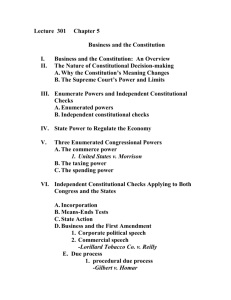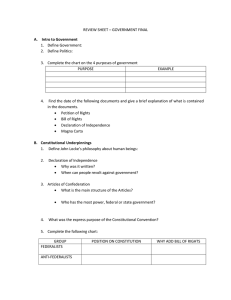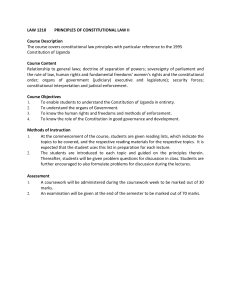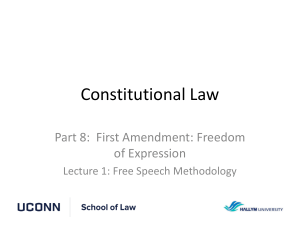Constitutional Law
advertisement
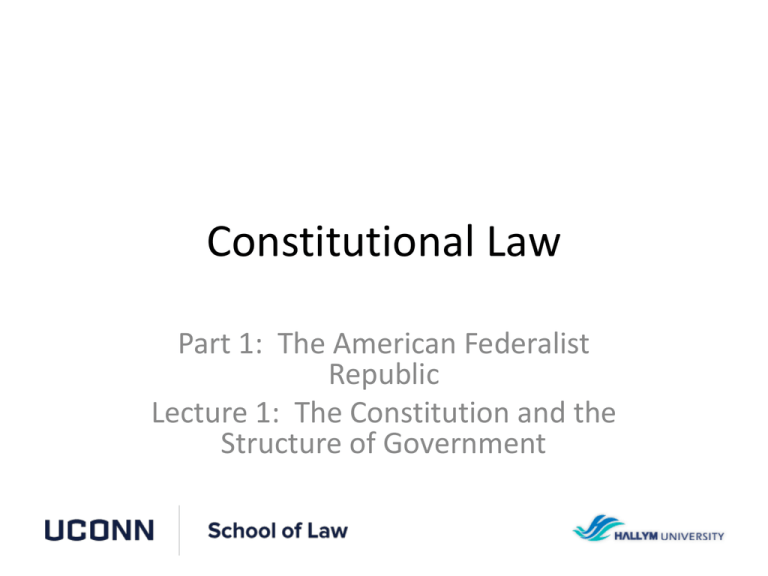
Constitutional Law Part 1: The American Federalist Republic Lecture 1: The Constitution and the Structure of Government The U.S. Constitution • 7 Articles – Articles 1 – 3 define the Branches of government – Articles 4 and 6 describe various government powers, duties, and limits on powers – Article 5 describes the process of amendment – Article 7 describes the requirements for ratification • 27 Amendments – Amendments 1 – 10 comprise the Bill of Rights (and were adopted at the same time as the Constitution) Constitutional Law – Professor David Thaw Part 1 Lecture 1 Slide 2 The U.S. Federal Powers • The U.S. Federal System – Primarily described by: • Articles 1, 2, 3 – the three Branches of government – Also: • Article 4, Section 1: Full Faith and Credit • Article 4, Section 2: Privileges and Immunities • Article 6, Clause 2: Supreme Law of the Land (Supremacy Clause) Constitutional Law – Professor David Thaw Part 1 Lecture 1 Slide 3 Branches of Government • Entities under the U.S. federal system: – The three Branches of government: • Article 1: Legislature (Congress) • Article 2: Executive (President and Federal Agencies) • Article 3: Judiciary (“Article 3” Courts) – Individual State governments • U.S. Constitutional Law is about understanding the relationships among these entities and the limitations on their powers Constitutional Law – Professor David Thaw Part 1 Lecture 1 Slide 4 Relationships Among Government • Relationships among government entities: Executive (President, Agencies) Legislature Judiciary (Congress) (Courts) States Constitutional Law – Professor David Thaw Part 1 Lecture 1 Slide 5 Limitations on Government • Limitations on the power of government entities: – Federal Power: • Enumerated powers only • Additionally limited by the Amendments – State Power: • All powers except those reserved for the Federal government or restricted by limitations in the Articles or Amendments Constitutional Law – Professor David Thaw Part 1 Lecture 1 Slide 6 “Checks and Balances” • The concept of “Checks and Balances” – Each Branch of government is “set against” each other branch • Examples: – President appoints Judges but the Senate (Legislature) confirms the appointments – President can veto legislation, but a super-majority of Congress can override the veto – The Courts determine what the laws mean and if they are valid under the Constitution • This is a theory of “internal restraint” Constitutional Law – Professor David Thaw Part 1 Lecture 1 Slide 7 Theory of “Internal Restraint” • A little historical background • From The Federalist No. 51: – “[how] shall we . . . maintain [] the necessary partition of power among the several departments laid down in the Constitution?” – “by [designing] the interior structure of the government as that its several constituent parts may, by their mutual relations, be the means of keeping each other in their proper places.” Constitutional Law – Professor David Thaw Part 1 Lecture 1 Slide 8 Theory of “Internal Restraint” • From The Federalist No. 51 (continued): – “it is evident that each department should have a will of its own” – “but the great security against a gradual concentration of the several powers in the same department consists in giving to those who administer each department the necessary constitutional means and personal motives to resist the encroachment of the others.” Constitutional Law – Professor David Thaw Part 1 Lecture 1 Slide 9 Theory of “Internal Restraint” • From The Federalist No. 51 (continued): – “If men were angels, no government would be necessary. If angels were to govern men, neither external nor internal controls on government would be necessary.” – “In framing a government [] administered by men over men, the great difficulty lies in this: you must first enable the government to control the governed; and [then] you must oblige it to control itself.” Constitutional Law – Professor David Thaw Part 1 Lecture 1 Slide 10




